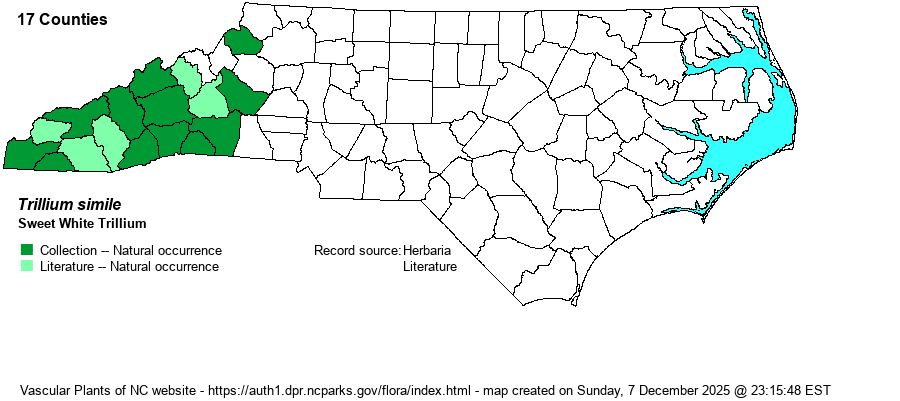| Author | Gleason | |
| Distribution | Throughout the southern and central Mountains, north to Yancey and Burke counties, with a slightly disjunct record north to Watauga County. It apparently occurs in the extreme western Piedmont foothills, as well. The ID of the Clay County specimen was questioned by the collector; it needs to be checked. The ID of the Watauga County specimen (at BOON) also needs to be checked.
This species has a very tight and limited range, though has been collected from nearly all counties within the range. It occurs only in western NC, eastern TN, northwestern SC, and northern GA. It was formerly included within Trillium erectum, but it and a number of other species have been pulled out and given full species status. | |
| Abundance | Uncommon to often at least locally common in the Mountains, and rare in the extreme southwestern Piedmont foothills. It is quite numerous, at least locally, in the Hickorynut Gorge region of western Rutherford and eastern Henderson counties. Though it is globally rare (a G3 Global Rank) and is given a State Special Concern status, it is not a rare mountain trillium in NC. The NC NHP has over 40 records in its database, though some are of historical occurrence. Nonetheless, the website editors strongly suggest a state rank of [S3] instead of the current S2 rank. In late 2024, the NCNHP moved the rank to S2S3. | |
| Habitat | This is another trillium that is essentially restricted to high pH soils of rich/moist hardwood forests. It grows mostly in Rich Cove Forests and Basic Mesic Forests, but it also grows in rich floodplain forests. |
| Phenology | Blooms from March into early May, and fruits in June and July. | |
| Identification | This is one of a good handful of white-flowered trillium species in the mountains and foothills. As it was originally included within T. erectum, it obviously shares the same general structure of that species. It is a fairly robust species, growing about 15 inches tall, with three very wide, essentially rhombic-shaped green leaves, each about 5 inches long and nearly as wide. The flower stalk is erect and about 2-3 inches tall, and the flower normally faces horizontally (as in T. erectum). However, T. simile is readily recognized by the quite wide and ovate petals, each about 2 inches long and at least 1 inch wide, and these petals are wide enough as to overlap their bases. Also, the petals are angled forward, to form a cup shape, and thus the flower is strongly three-dimensional. T. erectum has flowers somewhat in a single plane, with the narrower petals not forming a cup at the base nor typically overlapping at the bases. You should not have too much trouble finding this "new" species if you walk through some natural areas in the southern mountains, especially within several miles of Chimney Rock. There are other large populations much farther west toward TN, as well. And, if you are paying attention, identification should not really be an issue. | |
| Taxonomic Comments | As mentioned above, this taxon was formerly included within T. erectum, as were several other taxa. However, essentially all references consider the various differences between it and T. erectum to be significant and thus there is little issue with T. simile being a valid species.
| |
| Other Common Name(s) | Jeweled Wake-robin, Confused Trillium | |
| State Rank | S2S3 | |
| Global Rank | G3 | |
| State Status | SC-V | |
| US Status | | |
| USACE-agcp | | |
| USACE-emp | | |

